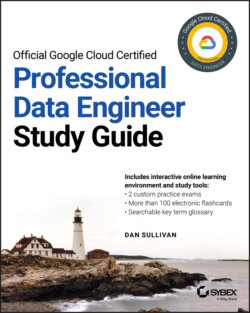Читать книгу Official Google Cloud Certified Professional Data Engineer Study Guide - Dan Sullivan - Страница 14
What Does This Book Cover?
ОглавлениеThis book covers the topics outlined in the Google Cloud Professional Data Engineer exam guide available here:
cloud.google.com/certification/guides/data-engineer
Chapter 1: Selecting Appropriate Storage Technologies This chapter covers selecting appropriate storage technologies, including mapping business requirements to storage systems; understanding the distinction between structured, semi-structured, and unstructured data models; and designing schemas for relational and NoSQL databases. By the end of the chapter, you should understand the various criteria that data engineers consider when choosing a storage technology.
Chapter 2: Building and Operationalizing Storage Systems This chapter discusses how to deploy storage systems and perform data management operations, such as importing and exporting data, configuring access controls, and doing performance tuning. The services included in this chapter are as follows: Cloud SQL, Cloud Spanner, Cloud Bigtable, Cloud Firestore, BigQuery, Cloud Memorystore, and Cloud Storage. The chapter also includes a discussion of working with unmanaged databases, understanding storage costs and performance, and performing data lifecycle management.
Chapter 3: Designing Data Pipelines This chapter describes high-level design patterns, along with some variations on those patterns, for data pipelines. It also reviews how GCP services like Cloud Dataflow, Cloud Dataproc, Cloud Pub/Sub, and Cloud Composer are used to implement data pipelines. It also covers migrating data pipelines from an on-premises Hadoop cluster to GCP.
Chapter 4: Designing a Data Processing Solution In this chapter, you learn about designing infrastructure for data engineering and machine learning, including how to do several tasks, such as choosing an appropriate compute service for your use case; designing for scalability, reliability, availability, and maintainability; using hybrid and edge computing architecture patterns and processing models; and migrating a data warehouse from on-premises data centers to GCP.
Chapter 5: Building and Operationalizing Processing Infrastructure This chapter discusses managed processing resources, including those offered by App Engine, Cloud Functions, and Cloud Dataflow. The chapter also includes a discussion of how to use Stackdriver Metrics, Stackdriver Logging, and Stackdriver Trace to monitor processing infrastructure.
Chapter 6: Designing for Security and Compliance This chapter introduces several key topics of security and compliance, including identity and access management, data security, encryption and key management, data loss prevention, and compliance.
Chapter 7: Designing Databases for Reliability, Scalability, and Availability This chapter provides information on designing for reliability, scalability, and availability of three GPC databases: Cloud Bigtable, Cloud Spanner, and Cloud BigQuery. It also covers how to apply best practices for designing schemas, querying data, and taking advantage of the physical design properties of each database.
Chapter 8: Understanding Data Operations for Flexibility and Portability This chapter describes how to use the Data Catalog, a metadata management service supporting the discovery and management of data in Google Cloud. It also introduces Cloud Dataprep, a preprocessing tool for transforming and enriching data, as well as Data Studio for visualizing data and Cloud Datalab for interactive exploration and scripting.
Chapter 9: Deploying Machine Learning Pipelines Machine learning pipelines include several stages that begin with data ingestion and preparation and then perform data segregation followed by model training and evaluation. GCP provides multiple ways to implement machine learning pipelines. This chapter describes how to deploy ML pipelines using general-purpose computing resources, such as Compute Engine and Kubernetes Engine. Managed services, such as Cloud Dataflow and Cloud Dataproc, are also available, as well as specialized machine learning services, such as AI Platform, formerly known as Cloud ML.
Chapter 10: Choosing Training and Serving Infrastructure This chapter focuses on choosing the appropriate training and serving infrastructure for your needs when serverless or specialized AI services are not a good fit for your requirements. It discusses distributed and single-machine infrastructure, the use of edge computing for serving machine learning models, and the use of hardware accelerators.
Chapter 11: Measuring, Monitoring, and Troubleshooting Machine Learning Models This chapter focuses on key concepts in machine learning, including machine learning terminology and core concepts and common sources of error in machine learning. Machine learning is a broad discipline with many areas of specialization. This chapter provides you with a high-level overview to help you pass the Professional Data Engineer exam, but it is not a substitute for learning machine learning from resources designed for that purpose.
Chapter 12: Leveraging Prebuilt ML Models as a Service This chapter describes Google Cloud Platform options for using pretrained machine learning models to help developers build and deploy intelligent services quickly. The services are broadly grouped into sight, conversation, language, and structured data. These services are available through APIs or through Cloud AutoML services.
